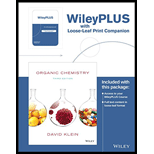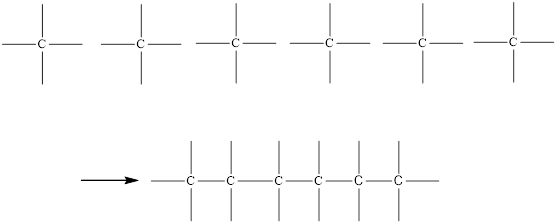
Concept explainers
(a)
Interpretation:
All the constitutional isomers that have the molecular formula
Concept Introduction:
- Isomers are compounds having same molecular formula but has different arrangements of atoms
- Constitutional isomers have same molecular formula but differ in the way their atoms are connected.
Steps to draw the constitutional isomers
- Valency of each atom that appears in the molecular formula has to be known.
- Atom with highest valency has to be connected first and the monovalent atom has to be placed at the periphery.
(a)
Explanation of Solution
Given molecular formula
Carbon is tetravalent and hydrogen is monovalent.
Since Carbon is tetravalent, it has to be connected first as given below,

The atom that has more than one bond is carbon and it should be drawn in the center of the compound.
On placing the hydrogen atom at the periphery, the isomers will be



 and
and 
(b)
Interpretation:
All the constitutional isomers that have the molecular formula
Concept Introduction:
- Isomers are compounds having same molecular formula but has different arrangements of atoms
- Constitutional isomers have same molecular formula but differ in the way their atoms are connected.
Steps to draw the constitutional isomers
- Valency of each atom that appears in the molecular formula has to be known.
- Atom with highest valency has to be connected first and the monovalent atom has to be placed at the periphery.
(b)
Explanation of Solution
Given molecular formula
Carbon is tetravalent, chlorine and hydrogen is monovalent.
Since Carbon is tetravalent, it has to be connected first as given below,

The atom that has more than one bond is carbon and it should be drawn in the center of the compound.
Here chlorine can be placed only at positions, i.e. connected to any one of the carbon.

On placing the hydrogen atom at the periphery, the isomer will be

(c)
Interpretation:
All the constitutional isomers that have the molecular formula
Concept Introduction:
- Isomers are compounds having same molecular formula but has different arrangements of atoms
- Constitutional isomers have same molecular formula but differ in the way their atoms are connected.
Steps to draw the constitutional isomers
- Valency of each atom that appears in the molecular formula has to be known.
- Atom with highest valency has to be connected first and the monovalent atom has to be placed at the periphery.
(c)
Explanation of Solution
Given molecular formula
Carbon is tetravalent, chlorine and hydrogen is monovalent.
Since Carbon is tetravalent, it has to be connected first as given below,

The atom that has more than one bond is carbon and it should be drawn in the center of the compound.
Here chlorine can be placed at two positions,
 and
and 
On placing the hydrogen atom at the periphery, the isomer will be
 and
and 
(c)
Interpretation:
All the constitutional isomers that have the molecular formula
Concept Introduction:
- Isomers are compounds having same molecular formula but has different arrangements of atoms
- Constitutional isomers have same molecular formula but differ in the way their atoms are connected.
Steps to draw the constitutional isomers
- Valency of each atom that appears in the molecular formula has to be known.
- Atom with highest valency has to be connected first and the monovalent atom has to be placed at the periphery.
(c)
Explanation of Solution
Given molecular formula
Carbon is tetravalent, chlorine and hydrogen is monovalent.
Since Carbon is tetravalent, it has to be connected first as given below,

The atom that has more than one bond is carbon and it should be drawn in the center of the compound.
Here chlorine can be placed at two positions.
 and
and 
On placing the hydrogen atom at the periphery, the isomer will be
 and
and 
Want to see more full solutions like this?
Chapter 1 Solutions
Organic Chemistry, 3e WileyPLUS Registration Card + Loose-leaf Print Companion
- Name the following carbohydrates give both the systematic and common names. Don't forget to identify the Isomer.arrow_forwardWhat is the product of the reaction of XeF4 with H2O? Group of answer choices H2XeF2 H2XeF4 XeO3 H2XeOarrow_forwardWhile noble gas exerts the strongest London (dispersion) forces on neighboring atoms? Group of answer choices Xe Ar Kr Nearrow_forward
- Which of the following elements is corrosive to your skin due to that element breaking down C=C bonds? Group of answer choices fluorine iodine bromine chlorinearrow_forwardWhat the best source of sulfide to use on a small scale in the lab? Group of answer choices thiourea H2S NaHS Na2Sarrow_forwardWhich of the following statements about sulfur is FALSE? Group of answer choices H2S is the product of an oxygen-depleted ecosystem. In the acid mine drainage reaction, FeS2 is a product. One allotrope of sulfur has the formula S20. In the environment, bacterial oxidation can convert S2− to elemental S or SO42−.arrow_forward
- Of the following choices, which is the best reason that most materials DON'T spontaneously combust even though our atmosphere is about 21% oxygen? Group of answer choices The reduction of O2 in the gas phase (O2 + e− → O2−) is spontaneous. The reduction of O2 in acid solution (O2 + H+ + e− → HO2(aq)) is spontaneous. O2 is not a reactant in combustion. The O2 bond dissociation energy is 494 kJ/mol, leading to a high activation energy for combustion.arrow_forwardplease answer in the scope of the SCH4U course, I am having a hard time understanding, may you show all steps please and thank you! can you also put the final answers in the table so its understandablearrow_forwardPlan the synthesis of the following compound using the starting material provided and any other reagents needed as long as carbon based reagents have 3 carbons or less. Either the retrosynthesis or the forward synthesis (mechanisms are not required but will be graded if provided) will be accepted if all necessary reagents and intermediates are shown (solvents and temperature requirements are not needed unless specifically involved in the reaction, i.e. DMSO in the Swem oxidation or heat in the KMnO4 oxidation). There may be more than one correct answer, and chemically correct steps will be accepted. Extra points will be given if correct names are provided. The points earned here will be applied to your lowest exam score! H Harrow_forward
- Draw the mechanism to make the alcohol 1-hexanol. Please use arrows.arrow_forwardAnswer the followings: 1-What is the difference(s) between DNA and RNA: a- Structure: b- Function: c- Types: 2-What is the meaning of: a- Replication b- Transcription c- Translation 3- Show the base pair connection (hydrogen bond) in DNA and RNAarrow_forwardWhy does the anhydride react with the OH on the benzene rather than the OH on the carboxy group?arrow_forward
 ChemistryChemistryISBN:9781305957404Author:Steven S. Zumdahl, Susan A. Zumdahl, Donald J. DeCostePublisher:Cengage Learning
ChemistryChemistryISBN:9781305957404Author:Steven S. Zumdahl, Susan A. Zumdahl, Donald J. DeCostePublisher:Cengage Learning ChemistryChemistryISBN:9781259911156Author:Raymond Chang Dr., Jason Overby ProfessorPublisher:McGraw-Hill Education
ChemistryChemistryISBN:9781259911156Author:Raymond Chang Dr., Jason Overby ProfessorPublisher:McGraw-Hill Education Principles of Instrumental AnalysisChemistryISBN:9781305577213Author:Douglas A. Skoog, F. James Holler, Stanley R. CrouchPublisher:Cengage Learning
Principles of Instrumental AnalysisChemistryISBN:9781305577213Author:Douglas A. Skoog, F. James Holler, Stanley R. CrouchPublisher:Cengage Learning Organic ChemistryChemistryISBN:9780078021558Author:Janice Gorzynski Smith Dr.Publisher:McGraw-Hill Education
Organic ChemistryChemistryISBN:9780078021558Author:Janice Gorzynski Smith Dr.Publisher:McGraw-Hill Education Chemistry: Principles and ReactionsChemistryISBN:9781305079373Author:William L. Masterton, Cecile N. HurleyPublisher:Cengage Learning
Chemistry: Principles and ReactionsChemistryISBN:9781305079373Author:William L. Masterton, Cecile N. HurleyPublisher:Cengage Learning Elementary Principles of Chemical Processes, Bind...ChemistryISBN:9781118431221Author:Richard M. Felder, Ronald W. Rousseau, Lisa G. BullardPublisher:WILEY
Elementary Principles of Chemical Processes, Bind...ChemistryISBN:9781118431221Author:Richard M. Felder, Ronald W. Rousseau, Lisa G. BullardPublisher:WILEY





